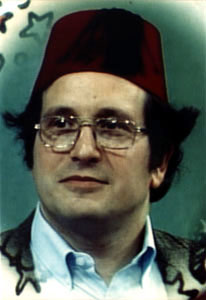Date: April 2, 2001
Real Video: 456 MB
Talk Introduction
We have witnessed and participated in great advances, in transportation, in computation, in communication, and in biotechnology. But the advances that look like giant steps to us will pale into insignificance by contrast to the even bigger steps in the future. Sometimes I try to imagine what we, the technologists of the second half of the 20th century, will be remembered for, if anything, hundreds of years from now.
I contend that at this moment in history we are at the beginning of an intellectual revolution based on the assimilation of computational ideas into our culture. We have been programming universal computers for about 50 years. The practice of computation arose from military, scientific, business, and accounting applications. Just as the early Egyptian surveyors probably thought of themselves as experts in the development and application of surveying instruments, we have developed a priestly cult of computer scientists. But, as I have pointed out: Computer Science is not a science, and its ultimate significance has little to do with computers. The computer revolution is a revolution in the way we think and in the way we express what we think.
I will defend this viewpoint with examples and demonstrations.
About the Speaker
Gerald Jay Sussman is the Matsushita Professor of Electrical Engineering at the Massachusetts Institute of Technology. He received the S.B. and the Ph.D. degrees in mathematics from the Massachusetts Institute of Technology in 1968 and 1973, respectively. He has been involved in artificial intelligence research at M.I.T. since 1964. His research has centered on understanding the problem-solving strategies used by scientists and engineers, with the goals of automating parts of the process and formalizing it to provide more effective methods of science and engineering education. Sussman has also worked in computer languages, in computer architecture and in VLSI design.
License
The colloquium series videos are licensed slightly differently than our normal classes. These are covered by the Creative Commons Attribution-NoDerivs license which allows free copying but does not allow for the creation of derivative works.

Gerald Jay Sussman is the Panasonic Professor of Electrical Engineering at the Massachusetts Institute of Technology (MIT). He received his S.B. and Ph.D. degrees in mathematics from MIT in 1968 and 1973 respectively. He has been involved in artificial intelligence research at MIT since 1964. His research has centered on understanding the problem-solving strategies used by scientists and engineers, with the goals of automating parts of the process and formalizing it to provide more effective methods of science and engineering education. Sussman has also worked in computer languages, in computer architecture and in VLSI design.
MDL (programming language)
From Wikipedia, the free encyclopedia
MDL (the MIT Design Language) is a descendant of the Lisp Programming language. Its initial purpose was to provide high level language support for the Dynamic Modeling Group at MIT's Project MAC. It was initially developed in 1971 on the PDP-10 computer under the Incompatible Timesharing System. The initial development team consisted of Gerald Sussman and Carl Hewitt of the Artificial Intelligence Lab, and Chris Reeve, Bruce Daniels, and David Cressey of the Dynamic Modeling Group. Later, Stu Galley, also of the Dynamic Modeling Group, wrote the MDL documentation.
MDL was initially known as “Muddle”. This style of self-deprecating humor was not widely understood or appreciated outside of Project MAC and a few other early citadels of information technology. So the name was sanitized to MDL.
MDL provides several enhancements to classical Lisp. It supports several built-in data types, including lists, strings and arrays, and also user-defined data types. It offers multithreaded expression evaluation and coroutines. Variables can carry both a local value within a scope, and a global value, for passing data between scopes. Advanced built-in functions supported interactive debugging of MDL programs, incremental development, and reconstruction of source programs from object programs.
Although MDL is obsolete, some of its features have been incorporated in later versions of Lisp. Gerald Sussman went on to develop the Scheme language, in collaboration with Guy Steele, who later wrote the specifications for Common Lisp and Java. Carl Hewitt had already published the idea for the PLANNER language before the MDL project began, but his subsequent thinking on PLANNER reflected lessons learned from building MDL. Planner concepts influenced languages such as Prolog and Smalltalk. Smalltalk and Simula, in turn, influenced his future work on the Actor model.
But the largest influence that MDL had was on the genre known as interactive fiction. An interactive fiction game known as Zork, sometimes called Dungeon, was first written in MDL. Later, Reeve, Daniels, Galley and other members of Dynamic Modeling went on to start Infocom, a company that produced many early commercial works of interactive fiction.
[edit] Code sample[1]
) ) ) ( > ) ( .RMS>> ) ( .RMS> .RMS>>> )>> .EXITS>>






没有评论:
发表评论